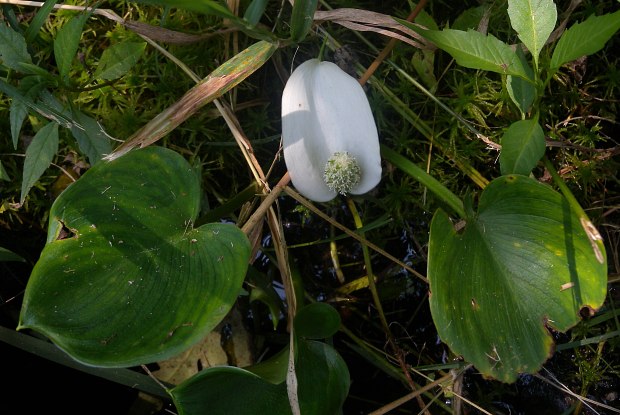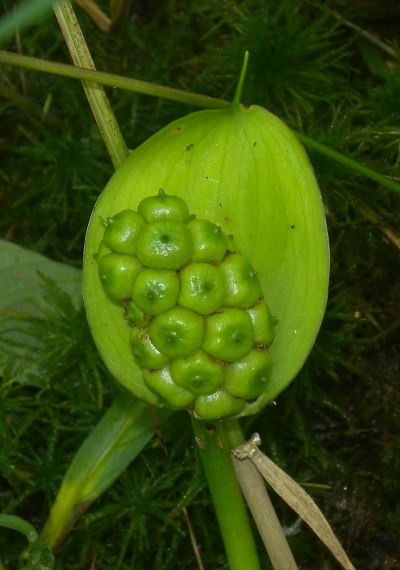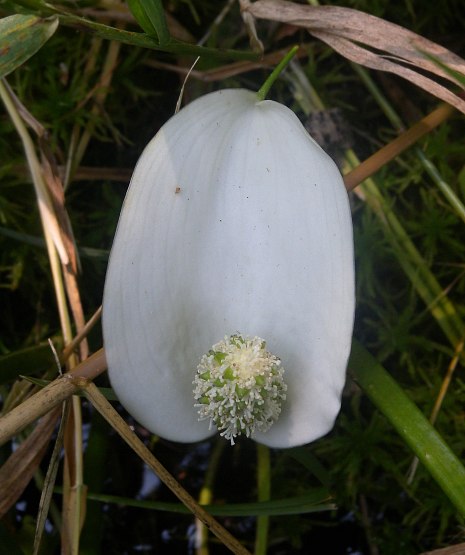
The spadix has mostly perfect (bisexual) flowers and some staminate (male) flowers at its apex, although sometimes the spadix lacks staminate flowers. These small flowers are densely arranged across the entire surface of the spadix and they are numerous. Each perfect flower has a green ovoid pistil that is surrounded at its base by 6-9 white stamens. The staminate flowers have only white stamens. Directly behind the spadix, there is a petaloid white spathe. The hairless spathe is about 1½–2½" in length, ovate to oval in shape, and tapering abruptly into a narrow linear tip up to 8 mm. (1/3") long; this tip is strongly involute (rolled tightly inward). Sometimes the back of the spathe is light green while it is in bloom. On rare occasions, 2-3 spathes may develop alongside the spadix. The blooming period occurs intermittently during the summer, lasting about 1-2 months for a colony of plants. Afterwards, the spadix and spathe turn green. The perfect flowers are replaced by globoid-obovoid berries with short tapered beaks; the spadix swells in size as the berries develop. Immature berries are green or greenish yellow, but they become bright red and 8–12 mm. (1/3–1/2") across at maturity. The interior of each berry contains gelatinous flesh and several seeds. The mature seeds are 6 mm. (¼") long, ellipsoid and somewhat flattened in shape, brown to dark brown, and minutely pitted. The root system is long-rhizomatous and fibrous. Colonies of clonal plants of varying size sometimes develop from the rhizomes at favorable sites.

Cultivation: The preference is partial sun to medium shade, wet conditions to shallow water, and an acidic peaty soil. Further to the north of Illinois, this plant tolerates full sun.
Range & Habitat: In Illinois, Wild Calla (Calla palustris) has been found only in Lake County, where it is native and still exists (see Distribution Map); it is state-listed as endangered. Illinois lies along its southern range-limit. This plant has a broad distribution in boreal areas of NE and north-central USA and southern Canada; it also occurs in boreal areas of Eurasia. In Illinois, Wild Calla is found primarily in shrubby areas of bogs, including shrubby areas adjacent to boardwalks where live sphagnum mosses occur. It also occurs in shallow pools of water in bogs, and on wet ground around Tamarack trees (Larix laricina). All of these habitats are high quality natural areas.

Faunal Associations: The flowers are visited primarily by flies, including Syrphid flies and carrion flies (Müller, 1873/1883; Knuth, 1909; Thomson, 1995). The foliage is toxic because it contains calcium oxalate; this substance is highly irritating to the gastrointestinal tract of vertebrate animals. Nonetheless, it has been reported that the young foliage of this plant is an important source of food for Black Bears during the spring in Minnesota when few sources of food are available (Rogers, 2011; Rogers et al., 1987).
Photographic Location: Shrubby area of a bog in Lake County, Illinois.

Comments: While the flowers of the spadices remain in bloom for only a short time, the white spathes of this plant remain attractive for a longer period of time. The glossy foliage and ripe red berries are also attractive. Wild Calla (Calla palustris) is the only species in its genus. It is an easy plant to identify when its inflorescence is present as no other plant produces anything like it in Illinois. The leaves of Wild Calla have a superficial resemblance to those of the more common Marsh Marigold (Caltha palustris), but the leaves of the latter have fine networks of veins and shallow teeth along the margins. Marsh Marigold also produces its yellow flowers during the spring, while Wild Calla produces its greenish white flowers during the summer. Another common name of Calla palustris is Water Arum.